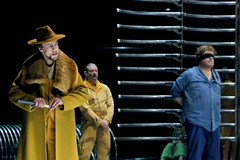| Opera Reviews | 25 April 2024 |
A compelling revival of Tristan und Isoldeby Tony Cooper |
|
| Wagner: Tristan und Isolde Bayreuth Festival August 2016 |
|
|
Widely considered to be one of the greatest works ever written to pure erotic love echoing the legendary days of King Arthur, Tristan - which Wagner rated one of his favourites - is an emotional work to say the least. And Katharina Wagner tapped into the opera’s emotional strength to deliver a brilliant, powerful and compelling production that drifted at times from its traditional staging especially at the end. However, Wagner doesn’t seem to mind taking chances of finding new ideas in which to explore the works of her great-grandfather whom, I’m sure, would approve. The first act is highly impressive not just musically speaking but visually, too. When we meet Tristan and Isolde they are already deeply in love and frantically searching for each other against all the odds, with Kurwenal and Brangäne battling hard to keep them apart but to no avail. However, when the lovers eventually meet it proves a powerful and emotive scene. They simply gaze longingly and lovingly at each other in total silence while the love potion that Brangäne prepares for Isolde is immediately discarded by her as the couple’s love is already sealed. But what helps to make this act so highly impressive and engaging is Frank Philipp Schlößmann and Matthias Lippert’s brilliantly-designed set comprising a three-dimensional labyrinth of stairs evaporating into thin air, an influence, perhaps, of Giovanni Piranesi or MC Escher. But it was Piranesi’s engraving Il ponte levatoio: Le Carceri d’Invenzione (The drawbridge: the Imaginary Prisons) cited in the programme. Overall, the visual impact was quite staggering greatly aided by Thomas Kaiser’s strikingly-designed costumes ranging from medieval to futuristic styles while Reinhard Traub’s atmospheric lighting reflected the dark and brooding nature of the piece seen to good effect in the final act. The scenario of Act II (in striking contrast to Act I) is played out in a prison exercise yard with more than a hint of DDR political interference in evidence as Stasi-styled guards (King Marke’s henchmen) look down upon the lovers forced into a tiny cell. They’re constantly kept under surveillance with ultra-bright searchlights trained upon them. Eventually, Tristan is blindfolded and stabbed in the back by Melot, notably sung by Raimund Nolte, who played the part with a slight hint of nervousness. But was he carrying out King Marke’s orders or secretly jealous of Tristan’s intense relationship with Isolde? It looked like the latter. In the final act, the staging is dark, atmospheric and cloaked in a thin hazy mist with the tension brought to breaking-point as Tristan tries in vain to reach out to his beloved Isolde one last time seeking her through a series of triangular mirrors representing, possibly, the romantic love triangle. They appear and disappear at whim the length and breadth of the stage reflecting a profusion of distorted images of Isolde driving Tristan to madness and insanity. But the deeply-etched ending where a distraught Isolde shields the dead body of Tristan in her arms with King Marke offering the couple his blessing is reinterpreted by Wagner. After the singing of the Liebestod, Marke quietly drags the body of Isolde (very much alive it seems but, maybe, an apparition) across a bare stage thereby claiming his rightful bride kidnapped by his nephew. American heldentenor Stephen Gould delivered a brilliant interpretation of Tristan cutting through the score like a knife through butter. Surely, the role belongs to him. But German bass, Georg Zeppenfeld (a favourite of the Green Hill) equally matched him with a commanding and confident performance as King Marke while Frankfurt-born singer, Petra Lang - a former mezzo but now hitting the soprano range - sang Isolde for the first time. Handpicked and coached for the part by Bayreuth’s music director, Christian Thielemann, she didn’t let him down. Her performance, especially in the Liebestod, was stunning to say the least and it more than stamped her authority on what is one of the most demanding of all Wagnerian female roles. And so did the orchestra which plays such a dominant role in this opera commenting on every psychological and dramatic development through leitmotivs and the endless melodising that Wagner substituted for arias and duets. Thielemann was on top form tackling the score with gusto and getting from his charges some rich, imaginative and warm playing that was simply thrilling to hear in the confines of the acoustically rich Festspielhaus.
|
|
| Text ©
Tony Cooper Photo © Bayreuther Festspiele / Enrico Nawrath |

 This production of Tristan und Isolde by Katharina Wagner first saw the light of day at last year’s festival immediately finding success with the cognoscenti of the Green Hill while also marking the 150th anniversary of its world première at Munich.
This production of Tristan und Isolde by Katharina Wagner first saw the light of day at last year’s festival immediately finding success with the cognoscenti of the Green Hill while also marking the 150th anniversary of its world première at Munich.





